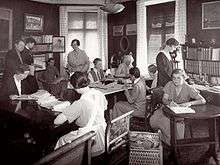Tidevarvet

Tidevarvet (meaning The Epoch in English) was a Swedish weekly political and feminist magazine existed between November 1923 and December 1936.
History and profile
Tidevarvet was established in 1923.[1] The first issue appeared on 24 November 1923.[2] The founders were five women, who were called the Fogelstad group: Kerstin Hesselgren, Honorine Hermelin, who was an educator, Ada Nilsson, who was a medical doctor, Elisabeth Tamm, a political politician, and Elin Wägner, who was an author.[3][4] The founders had a liberal political stance.[4] It was started on the initiatives of the Liberal Women’s National Association, which also established by the group.[5]
Tidevarvet stated its mission in the first issue as follows: the magazine would be a “forum, an arena in which men and women can work side by side to forge a broad-minded vision and find ways of implementing it in legislation and community life.”[6] The magazine was published on a weekly basis.[7][8] It adopted a radical political[8] and pacifist stance.[7] Elisabeth Tamm subsidised the magazine.[9]
The launching editor of the magazine was Ellen Hagen.[4] Then, Elin Wägner edited Tidevarvet from 1924 to 1927.[5] She was replaced by Carin Hermelin in the post.[4] Ada Nilsson also served as the editor-in-chief.[10] Honorine Hermelin and Moa Martinson were among the contributors.[11] The latter published notes about her visit to the Soviet Union in the magazine,[11] which continued to be an influential platform to discuss social and women-related issues in Sweden until 1935.[3]
The other significant contributors included Eva Andén, Emilia Fogelklou, Klara Johansson and Frida Steenhoff.[4] Tidevarvet ceased publication in December 1934.[12][13]
Hjördis Levin published a book about the magazine and its contributors, Kvinnorna på barrikaden (meaning Women on the Barricade in English).[4]
References
- ↑ "Tidevarvet 1923". Göteborgs Universitetsbibliotek. Retrieved 30 December 2016.
- ↑ "Tidevarvet cover page" (PDF). Tidevarvet. Retrieved 30 December 2016.
- 1 2 Lene Buchert. "Hesselgren, Kerstin (1872-1964)". Performance Magazine. Retrieved 30 December 2016.
- 1 2 3 4 5 6 "Tidevarvsgruppen (The Age Group), Fogelstad-gruppen (The Fogelstad Group) and the newspaper Tidevarvet (The Age.)". Hjördis Levin's homepage. Retrieved 30 December 2016.
- 1 2 Karl Erik Gustafsson; Per Rydén (2010). A History of the Press in Sweden (PDF). Gothenburg: Nordicom. ISBN 978-91-86523-08-4. Retrieved 13 February 2015.
- ↑ Helena Forsås-Scott. "Gas Mask Madonna". Nordic Women's Literature. Retrieved 30 December 2016.
- 1 2 Majken Jul Sørensen (5 January 2011). "Swedish Women's Civil Defence Refusal 1935–1956". War Resisters' International. Retrieved 29 December 2016.
- 1 2 "Report from Fogelstad". Moderna Museet. Retrieved 29 December 2016.
- ↑ Ebba Witt-Brattström. "From Man to Child". Nordic Women's Literature. Retrieved 29 December 2016.
- ↑ Alexandra Stang (2015). "Possibilities, Silences" (PhD Thesis). University of Helsinki. Helsinki. Retrieved 29 December 2016.
- 1 2 Dagmar Brunow (2009). "Allegory, Performativity, and Intervention: The Function of Travelogues in a Contested Space". Borders as Experience (PDF). Halmstad: School of Humanities, Halmstad University. Retrieved 29 December 2016.
- ↑ Helena Forsas-Scott (1 December 2000). Swedish Women's Writing 1850–1995. A&C Black. p. 269. ISBN 978-1-84714-197-2. Retrieved 29 December 2016.
- ↑ "Magazine" (PDF). Tidevarvet (45-46). Retrieved 30 December 2016.